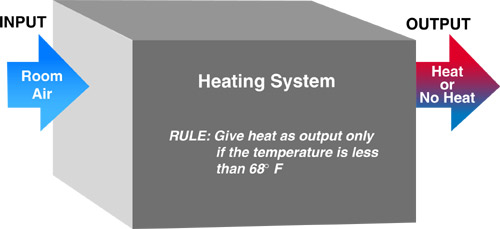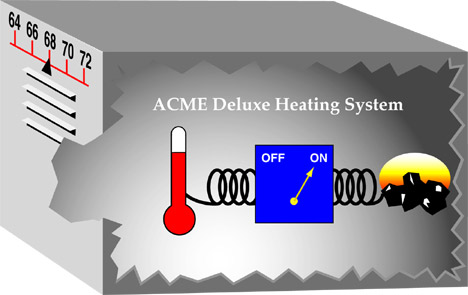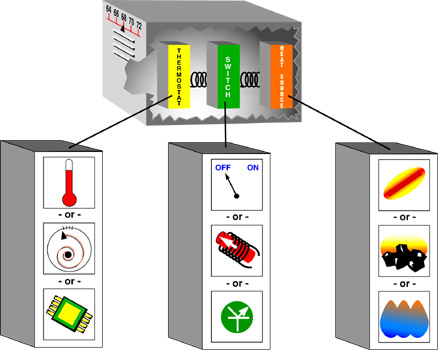Return to MODULE PAGE
Functionalism: An Introduction
David Leech Anderson: Author
For several thousand years, philosophers and theologians have speculated about the nature of the human mind. Many fascinating theories have been advanced to give an account of the essence of mental states. Throughout most of that history, the dominant views have assumed that the mind is something quite mysterious and fundamentally unlike anything else in the natural world. On that assumption, the mind would not be the kind of thing that could be studied with the methods of science.
It is only in the past century that attempts have been made to develop a "science" of the mind. For a theory of the mind to be scientific, it must be empirical. That is, it must give an account of the mind in terms of properties that are accessible to the five senses (sight, hearing, taste, touch and smell). If a theory of this kind can indeed capture the fundamental nature of the mind and cognition, then the mind would no longer be an inscrutable mystery, it could be studied just like anything else in nature. It would, as we say, be "publicly accessible."
In this section we will explore the most influential contemporary theory of the mind: functionalism. It is an empirical theory that has spawned a massive research effort that will, if it fulfills its promise, explain much about the mind that presently remains beyond our understanding. While functionalism dominates present research in the cognitive sciences, it remains a controversial theory. There exists a vocal minority who insist that functionalism fails to capture essential elements of "the mind". Later, we will examine some of the most famous arguments against functionalism. But for now it is worth noting that even those who reject the theory sometimes admit that there is no better empirical theory presently on the horizon. These same people often agree that research programs built upon the assumptions of functionalism are enormously useful. Even if functionalism is eclipsed or amended some day by a new theory, it is likely that any new theory will have benefited from the lessons learned by research programs that push functionalism to its limits. And so now we turn to functionalism, the most influential contemporary theory of the mind.
Of mousetraps, heating systems and functions
If you see a machine that you've never seen before, you might ask: "What is that contraption? What is its purpose? What is it for?" In asking those questions, you are asking for an explanation of the function that the machine serves. In many contexts, when we ask "What is it?" what we ultimately are asking for is an account of what it does.
Consider, for example, a mousetrap. If you know that someone has purchased a mousetrap, what you know is the function it performs. It is designed (either well or badly) to capture mice. There are dozens of types of mousetraps, from the familiar spring-loaded variety with cheese, to poisonous chemicals placed in a "mouse hotel". Knowing only that it is a mousetrap, you know nothing about how it performs its function or what materials it is made of. And for that, you may not care -- so long as it performs its function well. It is instructive that an expression has entered our language that focuses on the purely functional properties of mousetraps. If someone is trying to create a new invention, a new method of performing a familiar function, we say "they are trying to build a better mousetrap."
We can say the concept of a mousetrap can be realized (that is, made into a specific, tangible object) according to many different designs and using many different materials. To borrow an expression from cognitive science, we can say that mousetraps can be multiply realized in different physical contraptions. As we will come to learn, if functionalism is true, then minds can be multiply realized in different designs and different materials as well. But more about that later.
A functional description of a heating system
Let's consider the function of an automated heating system. Its primary function is to produce heat whenever the air temperature drops below a predetermined level. We can say that the system takes as input the air from the room and gives as output heat, as needed. If we assume that the heating system has been set for 68 degrees Fahrenheit, then we can say that its function is to produce heat if the temperature is below 68 degrees F, and to do nothing if the temperature is 68 degrees F or higher. As represented in the image below, it takes the air from the room as input, and it gives heat (or not) as output according to a rule.

Here, we are treating the entire heating system as a black box -- that is to say, we ignore what is inside the box. We are concerned only with the behavior of the system, not with its construction or the internal workings of its parts. Treating it as a black box we know only what its output is (i.e. how it behaves) in response to various inputs. Upon careful observation of its behavior, we would discover that this heating system implements the following function (or rule):
Give heat as output only if the temperature is less than 68 degrees.
If we get curious, though, and want to "peek inside" the black box, we will find whatever physical components are used to perform the functions of this particular automated heating system. For example, we might find the following:

As we examine the components that actually make the heating system function properly, we will find that there are several distinct devices, each making its own unique contribution to the system. The system pictured above, and most heating systems, include (among other things) the three following components:
- A thermostat
- A switch
- A heating source
Let's take the first device, the thermostat. If we are interested in how the device is actually constructed, we can examine it so closely as to be able to write complete blueprints that would enable us to reproduce the device in every detail. Such blueprints would identify the dimensions of each separate component of which it is constructed, it would specify the materials used to construct each component, and it would show precisely how all of the parts are arranged so as to operate properly. In the case of the heating system pictured above, we see that something like a familiar mercury (or red alcohol) thermometer is at the heart of the thermostat. A detailed blueprint would tell us what kind of glass the tube is made of, the shape of the glass, the volume of mercury enclosed within the glass, etc. A thermometer alone, however, does not a thermostat make. In addition to the mercury thermometer, there would have to be additional components capable of reading the temperature on the thermometer (a photoelectric sensor would work) and a device for determining whether the temperature recorded by the thermometer was or was not below the temperature on which the thermostat was set. (We have left these other components out of our picture for simplicity sake.)
We might have an interest in the physical properties of the thermostat, but we might not. We might instead be interested solely in the thermostat's functional properties. As a way of expressing this shift in perspective, we can imagine a black box which encloses the thermostat, hiding it from view. We can then do for the thermostat, what we had initially done for the entire heating system -- we can give a functional description of the thermostat, noting only what it takes as input and what it gives as output, ignoring completely how it succeeds in performing that function. The function of a thing is often called its causal role, that is, the effect that it has on other parts of the system (of which it is a part) and the effect that it has on the world around it. To speak of the function or the causal role of a thing, is not to speak of how it causes certain things to happen, but merely that it does so.
Just as we've given a functional description of the thermostat, we can do the same thing for two other key components of a heating system, the "switch" and the "heat source".

Each of the components of the heating system, above, is represented in functional terms not physical terms. We can see what goes into each black box and we can observe what output it gives in response to each input. If we pay attention, we may be able to discover the rule that it follows in giving a particular output for each input. For all this, we can see what it does, but not how it does it. Given that there are many ways to build a thermostat that performs the "temperature detecting" function, we say that a thermostat can be realized in many different ways.
There are many possible designs for a thermostat. At the heart of every thermostat is a thermometer, a device that can accurately detect the temperature of the air. Consider the three possible ways of building a thermometer as shown on the lefthand side of the image below. Each uses a different method to measure the air temperature. Any one of them will perform the same function, and so while their physical properties will be quite different, their functional properties will be identical.
Just as there are different ways of building thermostats, there are also different ways of building switches and heat sources. In the picture below, you can see three different ways of building (or realizing) each of the functional devices: thermostat, switch and heat source.

If you want to build a heating system, you can pick any thermostat from column A, any switch from column B and any heating source from column C. Connect them all together (with a little electrical wire and duct tape) and you will have a heating system.
Back to the functionalist theory of the mind
Functionalism is a theory of the mind that claims to tell us the fundamental nature of our mental states. Your mental states include everything from your fear of heights to your belief that it is Tuesday, from your desire to eat an ice cream cone to the sharp pain in your leg. Fears, beliefs, desires, pains are all mental states. Your mental states include the cognitive processing that you are aware of because they are accompanied by subjective experiences, or "feelings", of some kind. But they also include the cognitive processing that you are not aware of, like the way your visual system turns simple two-dimensional line-drawings into a three-dimensional "world".
So, what does your desire for an ice cream cone and the pain in your leg have to do with thermostats and heating systems? Well, according to functionalism, the essential nature of your desires and your pains is not to be found in the stuff that your desires are composed of, but rather in the function that each performs. What kind of stuff is your pain made of? Are pains somehow made of molecules (i.e., physical stuff)? Or are they made of some kind of immaterial mental stuff. According to functionalism, we can describe the essential features of our mental states without mentioning what kind of stuff it is made of. We need only describe what goes into and what comes out of each of the componenet black boxes. An account of a particular mental state, like pain, is complete when all of its functional properties have been identified. The stuff that is used to implement those functional properties is not an essential part of what mental states really are.
Now it must be said that virtually all contemporary functionalists are physicalists. That is, they believe that everything that exists is ultimately built out of physical stuff (molecules, etc.) as described by our best theories in physics. Being physicalists, they do not believe in the existence of immaterial, mental stuff. Further, even though a description of a mental state may not require any mention of the stuff of which it is made, it may, nonetheless, prove enormously helpful to carefully examine the stuff if you want to discover precisely what function the stuff performs. (That is, if you seek a thorough account of the causal role of pain in a particular organism, examining the activity of nerve endings and pain centers in the brain may provide relevant data.) Nonetheless, even though functionalists tend to be physicalists, they must concede that it is at least imaginable that pain could be realized in something other than molecules, just as we all must concede that a thermostat could be realized using something other than a mercury thermometer. Functional properties can always be (at least in principle) multiply realized.
Functionalism, the computer metaphor & ET
In our discussion of functionalism thus far, the word "computer" has not been mentioned. Yet, from the first time that functionalism was advanced as a theory of the mind (by the philosopher, Hilary Putnam, who is usually credited with being its first proponent in a paper called "Minds and Machines" 1960 ), it was explained using the computer metaphor. To say that mental states are functional properties, said Putnam, is to say that the mind is, in fundamental ways, like a computer program. Now, other people had already suggested that the mind was like a computer. In fact, the most popular theory of the mind at the time that functionalism was first introduced was a theory called the identity thesis. According to this theory, the mind was to be identified with the brain, and mental states were essentially brain states. Many who embraced this theory also appealed to the computer metaphor. They said that the brain was a computer and mental states were physical states of the brain/computer. But there is a crucial difference between the identity thesis according to which mental states are states of the computer's hardware and functionalism according to which mental states are states of the computer's software. If you define 'pain' as a physical state, then no creature anywhere in the universe could be in pain unless it was in the same physical brain state that we are in when we are in pain. But that doesn't seem right. If you've seen the movie ET: The Extraterrestrial, you've seen an alien from another planet suffer to help save the life of a child. If we assume that the physical structure of ET's brain is quite different from ours (which it would likely be), then it couldn't be in the same physical brain state that we are in when we are in pain. If so, then, we would have to say that ET couldn't be in pain. But that doesn't seem right. Surely it is possible for ET to be in pain, even if his brain is physically quite different from ours. (If you befriended ET like the boy in the movie, you would say that ET was in pain!).
Here is one of the strengths of functionalism. Since mental states, like pains, are functional states rather than physical states, then pains can be multiply realized in a wide range of different physical states, and thus in all types of strange and wonderful creatures. Just as the term, 'thermostat' picks out a functional concept, so does 'pain'. If something fulfills the function of a thermostat in a heating system, if it has the causal role that we described above -- then it is a thermostat. It doesn't matter what it's made of. Likewise, if something fulfills the function of pain in an alien from another planet, if it has the same causal role in ET that it has in us -- then it is a pain. It doesn't matter how the alien's brain is designed or what it's made of. It doesn't even matter if ET has a unique organ that can be described as a "brain". It is still possible that the very same mental state implemented in us can also be implemented in ET. According to functionalism, ET can be in pain!!
So where does that leave us? Well, we know that many contemporary scientists and philosophers believe that your mind is very like a piece of software running on your brain, the hardware. But that only tells us so much. Do we really know what a computer is? We see them every day, of course. But you may be surprised that there is quite a debate among scientists as to what things are and what are not computers. Is your brain really a computer? And if it is a computer, what kind of computer is it? The computer metaphor may offer a startling insight into the nature of our minds or it may be another theoretical dead end. But until we get clear about what computers are, we can't even tell whether the computer metaphor offers an interesting theory that makes a controversial claim about the nature of our minds, or whether it is a trivial claim that says virtually nothing of interest about our minds. So our next stop must be an exploration of nature of computers. We think that you will find an exploration of computers more interesting than you might expect. [If you want to explore the nature of computers, you can read "The Nature of Computers".]



